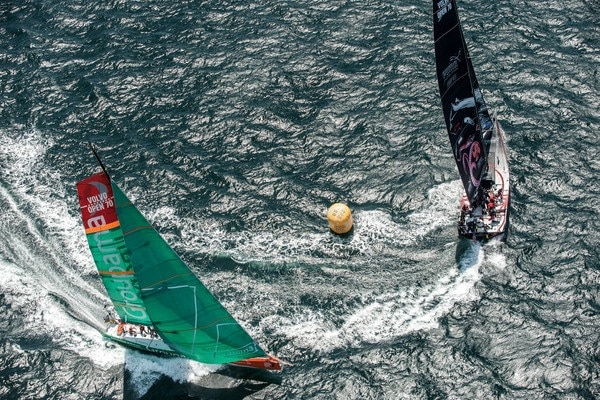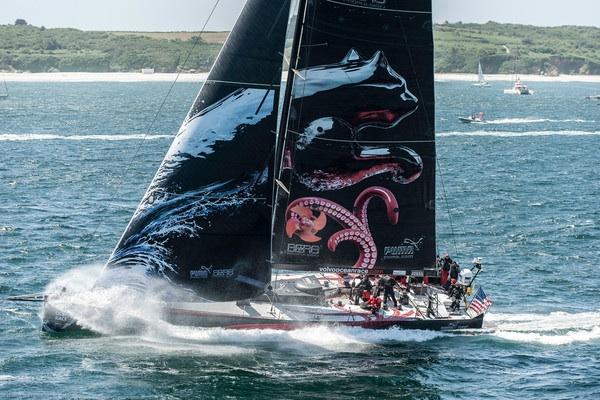
PUMA Ocean Racing Pro-Am Lorient B
We were beating up in a nice 20-plus knot wind off the coast of Lorient, France, this weekend when Ken Read, PUMA Ocean Racing’s skipper, asked me if I’d like to steer. I thought, Did he really just ask that? In my head, I responded “hell yeah, I want to steer this thing, what kind of question is that?” But out loud, I accepted the invite as politely and calmly as I could.
I had steered a Farr 40 recently, but the power and force that the Volvo Open 70-class boat exerted represented a whole different dimension of power. With a hull of more than 20 meters and a 31-meter mast, the force felt on the wheel was far more than anything I had experienced for a very long time. An adrenaline surge heightened my awareness of the very pleasant mid-60s weather and sunshine, as well as the Zodiac swerving in and out of my path.
“When was the last time you steered a sailboat going at 20 knots?” Read asked. I didn’t know exactly how to answer that.
Read handed me the wheel just after winning the first match in the Pro-Am contest of the Volvo Ocean Race during the Lorient stopover. It is almost expected that the guests on PUMA or any of the other boats would get to steer and grind during the race—in theory, that is. But that was not the case during the first race on PUMA, at least. Actually, one guest got to grind during the race, but he was a professional French skipper who was about to compete in the Québec-to-St.-Malo transat in a few weeks. He was definitely more qualified than the other invitees, who held on white-knuckled for dear life as the boat tilted with one reef to an angle more experienced sailors would consider comfortable. “Don’t hold onto that cable, it will take your hand off,” Read would say, followed by a more emphatic: “Like I said, that cable will kill you.”

PUMA Ocean Racing competes in the Pro-Am Race in Lorient, France. Photo: Paul Todd/Volvo Ocean Race
The guests on board included PUMA executives and an engineer from one of the boat’s suppliers. The Pro-Am does not count in the standings, but I think Read had winning too much on his mind to allow these passengers to participate in any racing maneuvers.
The Pro-Am race took place over the weekend followed by an in-shore match and then the last leg of the Volvo Race from Lorient to Galway. PUMA was a tad over 20 points from first-place Groupama, which was sailing in its home port. Catching up was/is theoretically possible, but winning would require an exceptional situation, such as if Groupama were to dismast during the final offshore leg before Galway while PUMA came in first place in all of the final offshore and inshore legs.
A couple of hours later after the first Pro-Am race, I was back at the port sipping a cold one when I learned that PUMA had ceded its first-place lead overall in the Pro-Am to Franck Cammas’ Groupama. Could things be getting personal?
Then, the next day, PUMA would make two jibing mistakes during the in-shore match, eventually costing the team a stab at the lead in that contest as they went on to place third. The French team once again took the top accolades as the Zodiacs and yachts that were often sailing too close or even in the racing zone cheered them on loudly.
At the time this is being written two days later, PUMA is in first place in the final off-shore leg and just rounded Fastnet with fewer than 115 miles to go before Galway. PUMA has an incredibly close lead of less than a mile over Telefonica and is fewer than two miles ahead of Groupama. All Groupama has to do is to cruise in towards the bottom of the pack to become the second French team ever to win the Volvo Ocean Race—yet it remains in striking distance of winning this leg as well.
Over the weekend, Read conceded that “a lot is riding on our shoulders” when asked if there was a lot of pressure on PUMA to represent the Anglo-Saxon racing community in this race. A lot more is riding on this final offshore leg heading into the port of Galway, I think, than just securing a second place finish overall.









